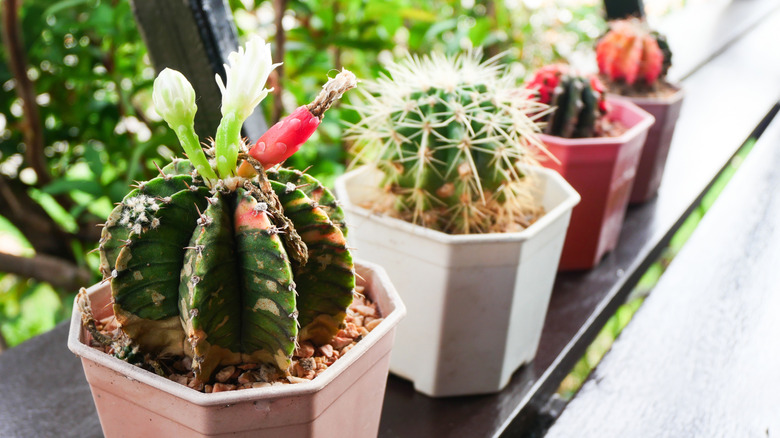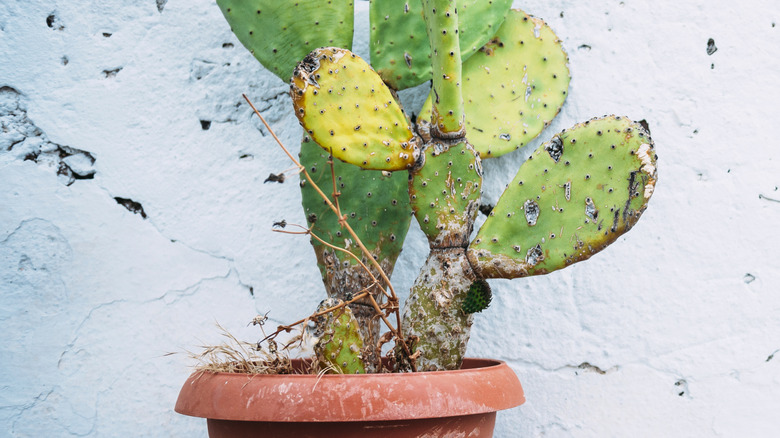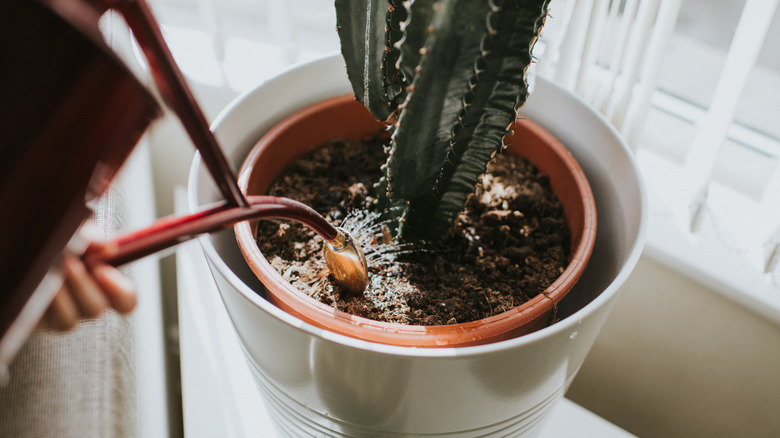The Reason Your Cactus Plant Is Oozing (And If You Should Be Concerned)
Cactus plants are infamous for being easy to look after. They are the go-to plants to grow for beginner gardeners who don't have their green thumbs yet, but that doesn't mean that they are indestructible. If you have cacti, you may have noticed your plants oozing white, black, or clear sap. It can be a worry to see these changes in your cactus plant, but oozing is not always a sign of disease or illness.
Certain cacti plants naturally ooze liquid. For example, barrel cacti (Ferocactus) produce nectar to attract ants that protect them from insects that may cause harm, so don't worry if you see these plants secreting liquid. However, your cactus plant may also be oozing because of overwatering, illness, or damage. To get to the bottom of why your cactus plant is oozing, you need to look at where it is coming from, what color the liquid is, and what type of cactus you have.
Why is my cactus oozing white liquid?
An opaque, milky-looking liquid oozing from a cactus plant is usually caused by damage or tissue injury. If your cactus has recently been cut or torn, the oozing is likely due to that damage. If so, give your plant time to heal while monitoring it for changes. Cacti are hardy plants, and the sap is part of the healing process as the oozing liquid will harden and seal the wound.
Certain plants, such as the pencil cactus (Euphorbia tirucalli), are sold under the cactus name but aren't actually cacti. They are euphorbia, and although they may look similar to cacti, they are a totally different species. All euphorbia plants secrete a white, milky sap. If your cactus plant is secreting a milky-looking liquid, take a moment to double-check if it is actually a cactus or not. The latex sap that these cacti secrete is an irritant to the skin, eyes, and mouth. It can cause serious damage to the cornea if it gets in your eyes and burning or blistering on the skin, so always use gloves when handling it.
Why is my cactus oozing water?
A cactus may ooze water because it is damaged or overwatered. Many varieties of cacti store water in their stems, and this means that the water will flow out when cut. If this is the case for your cactus plant, know that it will heal in time. If your cactus is oozing water regularly, it may be time to look at your watering routine, as overwatering can cause the cactus to retain excess moisture. If it is an outside potted plant, consider placing it somewhere sheltered to protect it from rain. If it is planted in the ground, you may need to look at the soil to determine if there are any drainage issues.
You can revive an overwatered indoor cactus plant pretty easily by either reducing the amount of water you provide it or repotting it in a more suitable container. Purchasing cacti soil that is made to drain quicker than typical potting soil ensures your cactus stays healthy and happy. Although the amount of water cacti plants need varies between types, the general rule of thumb is that if the soil feels wet, do not water it. Check the moisture of the soil by sticking your finger in a few inches. If it feels damp, it does not need more water. You may also want to look into getting a houseplant moisture meter.
Why is my cactus oozing black liquid?
Your cactus plant may be oozing black liquid because of a disease called bacterial necrosis. This disease is common in the saguaro (Carnegiea gigantea), but smaller varieties can be vulnerable to it, too. If your cactus is suffering from bacterial necrosis, it will usually look purplish-black on its tissue where the sap is coming from. The infected area has an intense, potent smell during the final stages of decay, and the disease can have dire consequences on your cactus plant.
If your cactus has bacterial necrosis, it will die if left untreated. However, there are measures you can take to bring your dying cactus back to life. You must remove any of the infected tissue from the plant and, if possible, 1 inch of healthy tissue that surrounds it. This is a preventative measure that will help your cactus fully heal from bacterial necrosis. Ensure that the tissue you cut out leaves a slope to allow water to drain. After removing the rotted tissue, clean the area with a mixture of 1 part bleach and 10 parts water. Sometimes the plant is too far gone for saving, and you must remove the structure altogether. Never leave your diseased cactus to die if it is among other plants, as this can risk damage to those plants through falling or infection.



